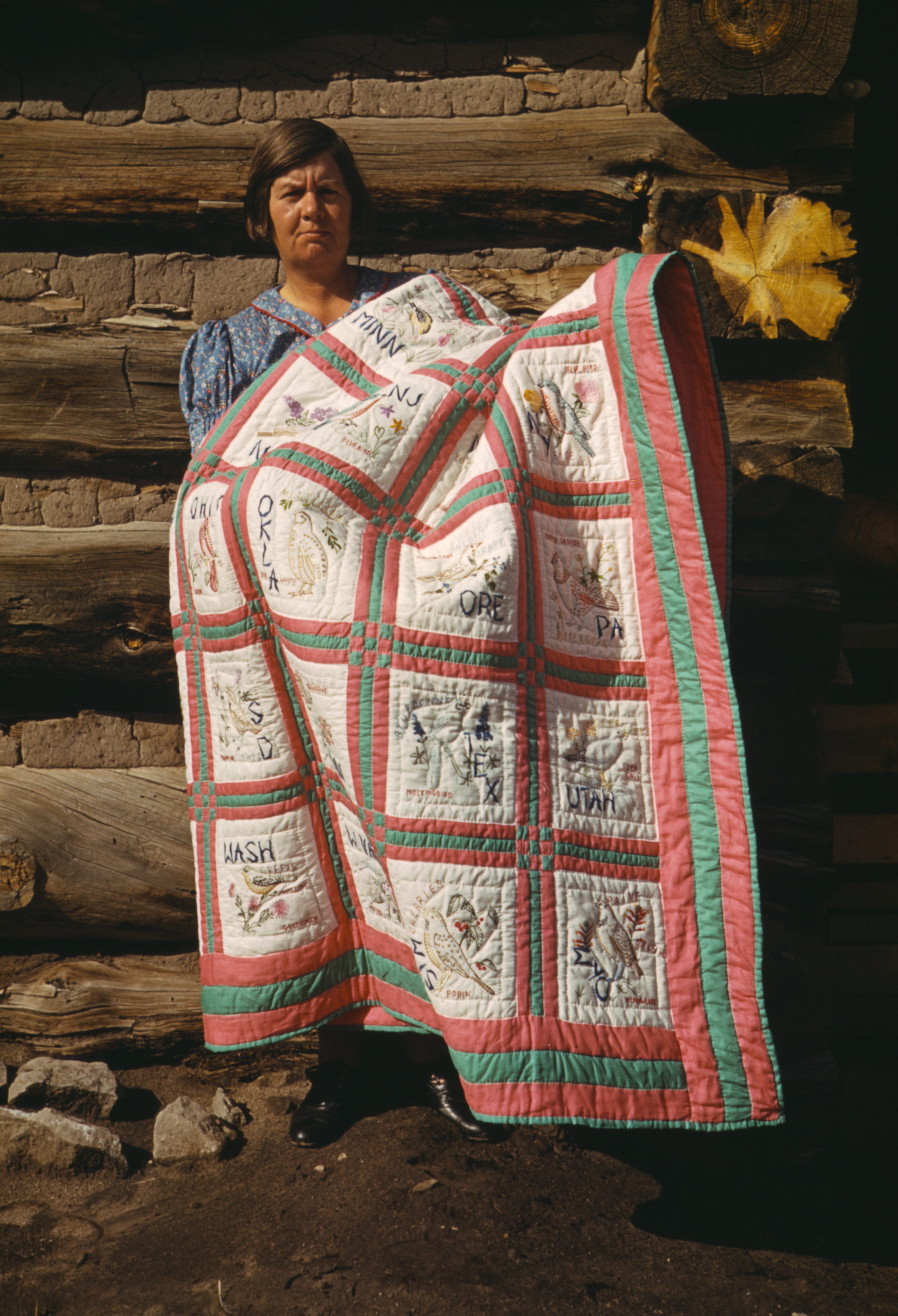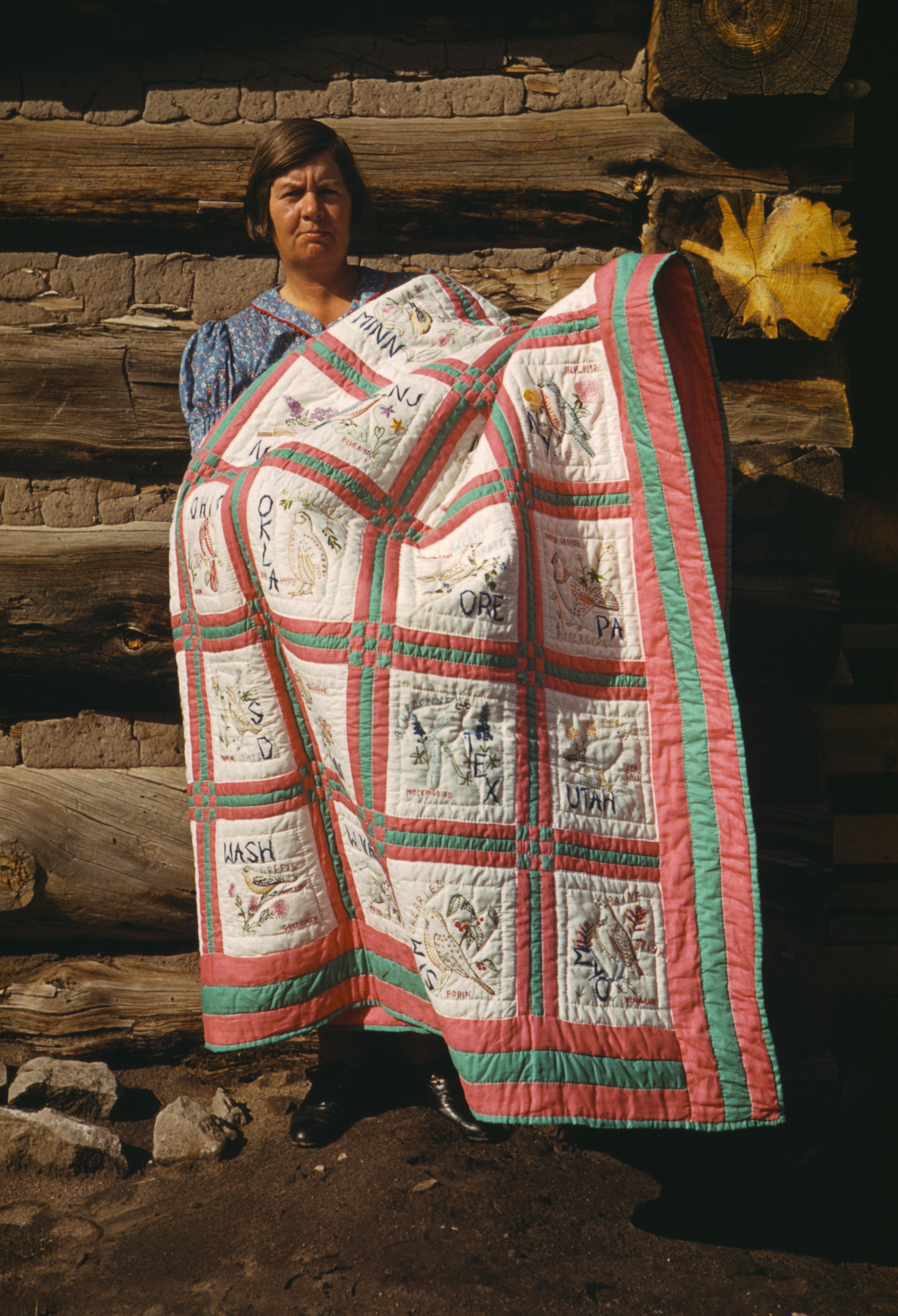|
Broderie Perse
Broderie perse (French for "Persian embroidery") is a style of appliqué which uses printed elements to create a scene on the background fabric. It was most popular in Europe in the 17th century, and probably travelled from India, as there are some earlier findings there. The technique could be considered an early form of puzzle piecing. Description Broderie perse can be done with any printed fabric on any ground, but it originally was worked with Chintz type fabrics. Chintz typically has clearly defined, separated motifs, which were cut out and invisibly applied onto the ground fabric. The typical intention was to create a scene from the motifs, but the decoration could also be random. The resulting fabric was often made into bedspreads, either unlined for summer or quilted for winter. They were typically saved for special occasions, such as guest beds. A noted example of Broderie perse is the central panel of the Rajah Quilt which was made by women as they were transported to T ... [...More Info...] [...Related Items...] OR: [Wikipedia] [Google] [Baidu] |
Quilt LACMA M
A quilt is a multi-layered textile, traditionally composed of two or more layers of fabric or fiber. Commonly three layers are used with a filler material. These layers traditionally include a woven cloth top, a layer of batting or wadding, and a woven back combined using the techniques of quilting. This is the process of sewing on the face of the fabric, and not just the edges, to combine the three layers together to reinforce the material. Stitching patterns can be a decorative element. A single piece of fabric can be used for the top of a quilt (a "whole-cloth quilt"), but in many cases the top is created from smaller fabric pieces joined, or patchwork. The pattern and color of these pieces creates the design. Quilts may contain valuable historical information about their creators, "visualizing particular segments of history in tangible, textured ways." In the twenty-first century, quilts are frequently displayed as non-utilitarian works of art but historically quilts were ... [...More Info...] [...Related Items...] OR: [Wikipedia] [Google] [Baidu] |
Appliqué
Appliqué is ornamental needlework in which pieces or patches of fabric in different shapes and patterns are sewn or stuck onto a larger piece to form a picture or pattern. It is commonly used as decoration, especially on garments. The technique is accomplished either by hand stitching or machine. Appliqué is commonly practised with textiles, but the term may be applied to similar techniques used on different materials. In the context of ceramics, for example, an appliqué is a separate piece of clay added to the primary work, generally for the purpose of decoration. The term originates from the Latin ''applicō'' "I apply" and subsequently from the French ''appliquer'' "attach". History The term appliqué is derived from French and Latin verbs ''appliquer'' and ''applicare'', respectively, which both mean to join or attach. Like embroidery, it has a humble beginning. The technique was used as a way to strengthen worn areas of items or to patch holes that had formed. Early a ... [...More Info...] [...Related Items...] OR: [Wikipedia] [Google] [Baidu] |
India
India, officially the Republic of India (Hindi: ), is a country in South Asia. It is the seventh-largest country by area, the second-most populous country, and the most populous democracy in the world. Bounded by the Indian Ocean on the south, the Arabian Sea on the southwest, and the Bay of Bengal on the southeast, it shares land borders with Pakistan to the west; China, Nepal, and Bhutan to the north; and Bangladesh and Myanmar to the east. In the Indian Ocean, India is in the vicinity of Sri Lanka and the Maldives; its Andaman and Nicobar Islands share a maritime border with Thailand, Myanmar, and Indonesia. Modern humans arrived on the Indian subcontinent from Africa no later than 55,000 years ago., "Y-Chromosome and Mt-DNA data support the colonization of South Asia by modern humans originating in Africa. ... Coalescence dates for most non-European populations average to between 73–55 ka.", "Modern human beings—''Homo sapiens''—originated in Africa. Then, interm ... [...More Info...] [...Related Items...] OR: [Wikipedia] [Google] [Baidu] |
Chintz
Chintz () is a woodblock printed, painted, stained or glazed calico textile that originated in Golconda (present day Hyderabad, India) in the 16th century. The cloth is printed with designs featuring flowers and other patterns in different colours, typically on a light, plain background. Name The name is derived from the hi, छींट, chīṁṭ, translit-std=IAST, , meaning 'spotted', 'variegated', 'speckled', or 'sprayed'. Since the 19th century the term has also been used for the style of floral decoration developed in those calico textiles, but then used more widely, for example on chintzware pottery and wallpaper. Chintz designs are derived from the style of Indian designs themselves reflecting Mughal art. A white base with floral and animal prints are its basic characteristics. Unglazed calico was traditionally called " cretonne". The word ''calico'' is derived from the name of the Indian city Calicut (Kozhikkode in native Malayalam), to which it had a manufacturin ... [...More Info...] [...Related Items...] OR: [Wikipedia] [Google] [Baidu] |
Rajah Quilt
''Raja'' (; from , IAST ') is a royal title used for South Asian monarchs. The title is equivalent to king or princely ruler in South Asia and Southeast Asia. The title has a long history in South Asia and Southeast Asia, being attested from the Rigveda, where a ' is a ruler, see for example the ', the "Battle of Ten Kings". Raja-ruled Indian states While most of the Indian salute states (those granted a gun salute by the British Crown) were ruled by a Maharaja (or variation; some promoted from an earlier Raja- or equivalent style), even exclusively from 13 guns up, a number had Rajas: ; Hereditary salutes of 11-guns : * the Raja of Pindrawal * the Raja of Morni * the Raja of Rajouri * the Raja of Ali Rajpur * the Raja of Bilaspur * the Raja of Chamba * the Raja of Faridkot * the Raja of Jhabua * the Raja of Mandi * the Raja of Manipur * the Raja of Narsinghgarh * the Raja of Pudukkottai * the Raja of Rajgarh * the Raja of Sangli * the Raja of Sailana * the R ... [...More Info...] [...Related Items...] OR: [Wikipedia] [Google] [Baidu] |
History Of Quilting
The history of quilting, the stitching together of layers of padding and fabric, may date back as far as 3400 BCE. For much of its history, quilting was primarily a practical technique to provide physical protection and insulation. However, decorative elements were often also present, and many quilts are now primarily art pieces. Europe In Europe, quilting appears to have been introduced by The Crusades, Crusaders in the 12th century (Colby 1971) in the form of the aketon or gambeson, a quilted garment worn under armour which later developed into the Doublet (clothing), doublet, which remained an essential part of fashionable men's clothing for 300 years until the early 1600s. One of the earliest existing decorative works is the Tristan Quilt, made around 1360 in Sicily. It is one of the earliest surviving quilts in the world and at least two sections survive, located at the V&A Museum (London) and in Bargello palace (Florence). Another of the Tristan and Isolde story is held in ... [...More Info...] [...Related Items...] OR: [Wikipedia] [Google] [Baidu] |



